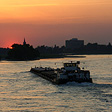COLOGNE CATHEDRAL
Gothic Bell Towers on the Rhine and the Three Kings
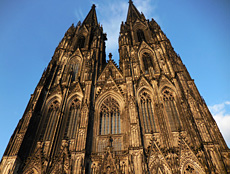 After Notre Dame in Paris it is perhaps the most famous Gothic Cathedral, with its massive towers, the largest of its kind in Europe with the second tallest spires. The Cologne Cathedral, officially the St Peter Cathedral Church was once the tallest building in the world, but its impressive bell towers which give it its famous massive façade are not really medieval, but technically neo-Gothic. The great church was begun in 1248, but construction was stopped in 1473. It remained uncompleted for 400s year with a medieval construction crane stuck on the roof, like a feather in a rakish cap until the mid-19th Century, when based on the original plans, but with more modern construction techniques in the rediscovered romantic Gothic revival of the time, the great towers were finished.
After Notre Dame in Paris it is perhaps the most famous Gothic Cathedral, with its massive towers, the largest of its kind in Europe with the second tallest spires. The Cologne Cathedral, officially the St Peter Cathedral Church was once the tallest building in the world, but its impressive bell towers which give it its famous massive façade are not really medieval, but technically neo-Gothic. The great church was begun in 1248, but construction was stopped in 1473. It remained uncompleted for 400s year with a medieval construction crane stuck on the roof, like a feather in a rakish cap until the mid-19th Century, when based on the original plans, but with more modern construction techniques in the rediscovered romantic Gothic revival of the time, the great towers were finished.
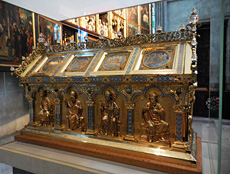 The Cologne Cathedral was built on the spot of earlier churches and before that, Roman structures. The cathedral was built to house the relics of the Three Kings, brought to Germany from Milan by Frederick Barbarossa after his conquest of Northern Italy in 1164. The bones of the reputed three wise men became the draw for pilgrims to the growing city on the Rhine. Still to be seen as the main attraction inside, the reliquary Shrine of the Three Kings, created by Nicolas of Verdun, under the commission of the Archbishop of Cologne Philip von Heinsberg in 1190, is a box of silver and bronze in the shape of a basilica church gilded with gold and architectural details. It was opened during the time of the construction in the 1860s and had some bones and garments inside. A share of the relics were returned to Italy in a diplomatic gesture.
The Cologne Cathedral was built on the spot of earlier churches and before that, Roman structures. The cathedral was built to house the relics of the Three Kings, brought to Germany from Milan by Frederick Barbarossa after his conquest of Northern Italy in 1164. The bones of the reputed three wise men became the draw for pilgrims to the growing city on the Rhine. Still to be seen as the main attraction inside, the reliquary Shrine of the Three Kings, created by Nicolas of Verdun, under the commission of the Archbishop of Cologne Philip von Heinsberg in 1190, is a box of silver and bronze in the shape of a basilica church gilded with gold and architectural details. It was opened during the time of the construction in the 1860s and had some bones and garments inside. A share of the relics were returned to Italy in a diplomatic gesture.
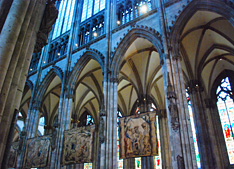 The church is of an impressive scale. The choir stalls of 104 seats are the largest in Germany. The chancel paintings were added in around 1340 and above them are older pillar sculptures of Jesus, Mary and the 12 Apostles. In addition to a depiction of the Adoration of the Magi to go with the relics, an entire cycle of glass windows in the upper floor of the central nave depicts forty-eight other kings and royalty. A prominent sculpture of Saint Christopher watches over the throng of travelers wandering the floor below him.
The church is of an impressive scale. The choir stalls of 104 seats are the largest in Germany. The chancel paintings were added in around 1340 and above them are older pillar sculptures of Jesus, Mary and the 12 Apostles. In addition to a depiction of the Adoration of the Magi to go with the relics, an entire cycle of glass windows in the upper floor of the central nave depicts forty-eight other kings and royalty. A prominent sculpture of Saint Christopher watches over the throng of travelers wandering the floor below him.
The cathedral was damaged by bombs during World War Two, but survived mostly intact because the spires were used as a reference guide for aerial bombers. There was a violent tank battle on the square in front of the church at the close of the war in 1945 and the burned out remains of a Panzer tank sat outside for a couple of decades as a reminder.
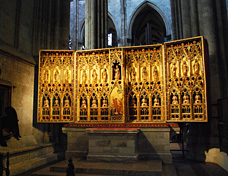 The Cologne Cathedral became one of the most important of the late medieval churches for its location in the transit hub of the Rhine River and today is one of the easiest of the great churches to get to while traveling in Germany. It is located directly next to the main train station of Cologne. It is so convenient for tourists to Germany to visit while traveling by train to stop at the station between trains and cross the plaza. The views of the church are a little spoiled by rail bridges and nearby modern structures. A city ordinance has to be passed to keep tall buildings from being built around it.
The Cologne Cathedral became one of the most important of the late medieval churches for its location in the transit hub of the Rhine River and today is one of the easiest of the great churches to get to while traveling in Germany. It is located directly next to the main train station of Cologne. It is so convenient for tourists to Germany to visit while traveling by train to stop at the station between trains and cross the plaza. The views of the church are a little spoiled by rail bridges and nearby modern structures. A city ordinance has to be passed to keep tall buildings from being built around it.
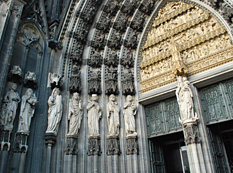 The design of the cathedral is based on the style of the Cathedral of Amiens, but with a distinct Germanic flavor. The foundation was laid in 1248, under Archbishop Konrad von Hochstaden. The eastern section with the choir was completed in 1322 and used while other sections were built. The west front façade was begun in the mid-1300s, but stopped in 1473 when the cathedral got caught up in a power feud between Ruprecht of Palatine the Archbishop of Cologne and the territorial lords of the region, which turned into a war between Westphalia and Hesse for about 7 years, leaving the south tower only partially completed up to the belfry and the nave unfinished. Work continued intermittently until the protestant reformation of Martin Luther in the mid-1500s, when focus shifted to newer Protestant churches.
The design of the cathedral is based on the style of the Cathedral of Amiens, but with a distinct Germanic flavor. The foundation was laid in 1248, under Archbishop Konrad von Hochstaden. The eastern section with the choir was completed in 1322 and used while other sections were built. The west front façade was begun in the mid-1300s, but stopped in 1473 when the cathedral got caught up in a power feud between Ruprecht of Palatine the Archbishop of Cologne and the territorial lords of the region, which turned into a war between Westphalia and Hesse for about 7 years, leaving the south tower only partially completed up to the belfry and the nave unfinished. Work continued intermittently until the protestant reformation of Martin Luther in the mid-1500s, when focus shifted to newer Protestant churches.
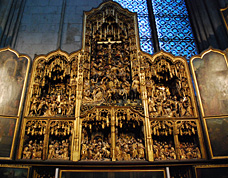 Two significant events happened in the 1800s to change the fortunes of the unfinished church. In 1815, Cologne became part of Prussia under Frederick William III after the Napoleonic wars ended and in 1840, the Prussian king died and his son came to the throne in Berlin as Frederick William IV. The son was referred to as a “romanticist”, a onetime draftsman and architectural enthusiast who, inspired by the romantic movement in literature and art was one of the forces behind the Gothic revival in Germany. In 1842, the original plan for the façade of the cathedral was found and the project was launched to finish the building, supported a third by Prussian state funds and a civic foundation formed to raise the rest of the huge cost. This was happening at the same time that England’s Queen Victoria married the German Albert of Saxe-Coburg, and the neo-Gothic revival was spreading there.
Two significant events happened in the 1800s to change the fortunes of the unfinished church. In 1815, Cologne became part of Prussia under Frederick William III after the Napoleonic wars ended and in 1840, the Prussian king died and his son came to the throne in Berlin as Frederick William IV. The son was referred to as a “romanticist”, a onetime draftsman and architectural enthusiast who, inspired by the romantic movement in literature and art was one of the forces behind the Gothic revival in Germany. In 1842, the original plan for the façade of the cathedral was found and the project was launched to finish the building, supported a third by Prussian state funds and a civic foundation formed to raise the rest of the huge cost. This was happening at the same time that England’s Queen Victoria married the German Albert of Saxe-Coburg, and the neo-Gothic revival was spreading there.
The bells were finally installed in the 1870s and the cathedral was completed in 1880, with a national celebration held on August 14, attended by the first German Emperor of the second empire reunified German states, Wilhelm I, 632 years after the cathedral foundation stone had been laid.
Cathedral Treasury
In the sacristy crypt below the main floor, the Cathedral Treasury (Schatzkammer) displays the ecclesiastical riches dating as far back to the 4th century, including rich artworks of gold, silver, bronze and ivory, reliquary, liturgical items, garments and insignias of Archbishops.
Visiting Cologne Cathedral
The cathedral is free to visit and open daily from 6 am to 7.30 pm (November-April) and 6 am to 9 pm (May-October). Opening hours on Sundays and Holidays are 1pm to 4.30pm. The Treasury has an admission price of €4 or €2 concession. The south bell tower can be climbed for view of the Rhineland and a close-up look at St Peter’s Bell, the large free swinging bell in the world, with an admission price of €3. Guided Tours are available. If visiting while traveling, leave your luggage at the station as bags are not allowed inside.© Bargain Travel EuropeReviews and travel deals on the Rhine River at TripAdvisor
Web Info
Koelner Dom
These articles are copyrighted and the sole property of Bargain Travel Europe and WLPV, LLC. and may not be copied or reprinted without permission.
See Also:
AUGSBURG CATHEDRAL VIRGIN MARY
MARKET CHURCH HALLE - MARTIN LUTHER DEATH MASK
SPEYER CATHEDRAL - EMPEROR'S SPIRES

